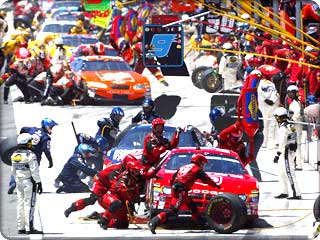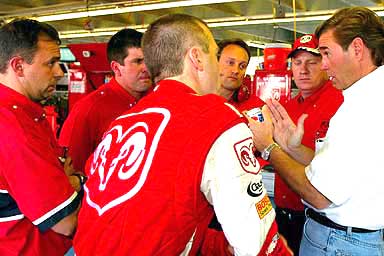After Bob Dowens finished playing college football, he
turned pro. But not in the NFL -- in the National Association for Stock Car Auto
Racing.
Once a defensive back at Fairleigh Dickinson University, Dowens, 28, is now a professional
tire carrier in a NASCAR pit crew. At Evernham Motorsports, based near Charlotte,
the stock-car racing team for which Dowens works, pit-crew members practice five
days a week. A pit coach studies videos to hone their footwork and hand speed. A
trainer has them lift weights and run sprints.
"This is a professional sport as far as I'm concerned," Dowens said recently,
drenched in sweat after a morning workout. "It's 95 degrees out, and today we
were running an obstacle course. This is as tough as any football practice."

Years ago, mechanics who worked on race cars during the week simply did double duty
on Sundays in the pits. Nobody thought about athletic fitness, and beer bellies were
OK. The crew was too busy during the week welding and machining to practice pit stops.
Today, teams like Evernham look increasingly for college athletes whose strength
and speed can save precious tenths of a second in a race. One of Dowens' teammates,
jack-man Ed Watkins, was a 300-pound offensive lineman at East Carolina University.
The Chip Ganassi Racing team's pit crew includes baseball players from Wake Forest
University; football players from Wake, the University of Kentucky and UNC Chapel
Hill; and a hockey player from Dartmouth.
Top tire-changers -- the guys who air-wrench lug nuts off and on -- can make $100,000
a year. The average at Evernham is about $60,000. Dowens figures he'll be a bit over
that, with bonuses, this year.
Twenty years ago, pit crews were doing pretty well to change four tires in less than
30 seconds. Today, taking more than 16 seconds can be disastrous.
A car going 200 miles per hour covers nearly 300 feet in a second, so a half-second
advantage in the pit can put a driver ahead two or three spots. "In our world,
two seconds is a lifetime," says Evernham's pit coach, Greg Miller, 33.
A pit crew consists of seven men: A front-tire changer, another for the rear; front-
and rear-tire carriers; a man who jacks the car up, and two gas men with an 11-gallon
can.
At Evernham, Miller expects tire changers to remove five lug nuts in 1.2 seconds.
The jack man should haul his 25-pound aluminum jack from the car's right side to
the left in 3.8 seconds. For tire carriers like Dowens, the key is the time it takes
to "index" a 60-pound tire, or get it from resting on the ground to mounted
on the car. Seven-tenths of a second is acceptable.
After getting a degree in sociology at Fairleigh Dickinson, in Madison, N.J., in
2001, Dowens started looking for a job. His gridiron abilities caught the eye of
Ray Evernham, a NASCAR executive who had just started his own team. He is related
to Dowens by marriage and had seen him in action. "Bob was the kind of guy we
look for -- strong, fast, mentally tough," Evernham says.
That brought Dowens under the tutelage of Evernham's coach, Miller. A former fitness
trainer with a master's degree in physiology, he thought he could combine his profession
with his love of NASCAR and joined a team in 1998. At Evernham, Miller keeps a thick
binder with details of every practice and race-day pit stop of the three crews he
coaches, with times of each man's tasks, the car's position entering and leaving
the pit.
Last year, Miller added a full-time strength coach. It's paying off. At 5 feet 10
inches, Dowens weighs 190 pounds, 20 pounds less than in his football days. The 6-foot-3-inch
Watkins is a buff 230. In May, an Evernham crew came in second in a NASCAR pit competition.
Two weeks later, a different Evernham pit crew took the title and shared $75,000
in bonus money.

One Thursday, in an Evernham shop, sparks flew from screeching grinders and welding
torches as mechanics prepped a dozen Dodge Chargers. Four large windows revealed
an adjacent room where Dowens and his teammates were doing their own body work, pumping
dumbbells, riding exercise bikes, stretching.
Later, they met at the practice pit outside. A few yards away, on a stretch of grass,
stood four orange cones left out from running drills. A red Charger roared into the
pit. In a flash, Watkins had the car's right wheels off the ground. Air wrenches
whined as tires rolled away. The crew shifted to the left side and suddenly it was
over.
The seven team members then gathered around Miller and a video screen. The time,
14.30 seconds, was OK. Miller watched the video frame by frame and then spotted something:
One tire carrier had his feet too far apart, which left him using only his arms,
not his legs, to index the tire. The next two attempts were better. The fourth was
clocked at 13.57 seconds.
Better. But racing is the pursuit of perfection.
"We're still leaving a little on the table," Miller said.
Amount of time tire changer is expected to remove five lug nuts from tire. Amount
of time the jack-man is expected to move a 25-pound jack from one side of the car
to the other. Amount of time tire carriers have to move a 60-pound tire from resting
on the ground to mounted on the car.
|